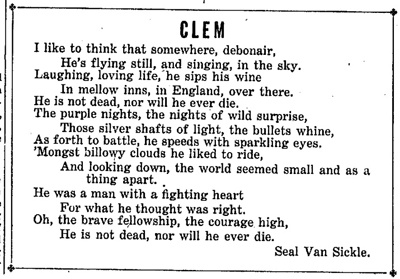CLEM WEIDENFELLER IS KILLED IN ACTIVE SERVICE IN ENGLAND
WAS PILOT OFFICER IN ROYAL CANADIAN AIR FORCE
Had Been in the Fighting Only Two Months;
Telegram Brings Sad News To His Family.
The war in Europe was brought home to this community with dreadful clarity and suddenness last Thursday when Mr. and Mrs. Tony Weidenfeller received word that their son, Clem, had been killed. He was a pilot officer in the Royal Canadian Air Force.
First tragic word received by the Weidenfellers was a telegram from the chief of air staff in Ottawa, Canada’s capital city. The wire read:
I DEEPLY REGRET TO INFORM YOU ADVICE HAS BEEN RECEIVED FROM THE R.C.A.F. CASUALTIES OFFICER OVERSEAS THAT YOUR SON, PILOT OFFICER CLEM RICHARD BERNARD WEIDENFELLER, CAN. J. F. FIVE ONE NAUGHT SIX, WAS KILLED ON ACTIVE SERVICE NOV. 4. SINCERE SYMPATHY. LETTER FOLLOWS. ~CHIEF OF AIR STAFF.
Thus it was that knowledge came here that a young man of Hawarden, the son of a father born in Germany and a mother born in The Netherlands, had died in the fighting service of Canada. Where he met his death—or how—is not yet known here.
LETTER ARRIVES.
Only additional word received so far was a letter which arrived here Wednesday from L. S. Breadner, vice-marshal, chief of air staff, R.C.A.F., together with a set of mimeographed instructions concerning the routine disposal of the personal effects of men killed in war.
Vice-Marshal Breadner’s letter read:
“I have learned with deep regret of the death of your son, Pilot Officer Clem Richard Bernard Weidenfeller, on active service overseas on Nov. 4, and wish to offer you and Mrs. Weidenfeller my sincere and heartfelt sympathy.
“It is so unfortunate that a promising career should be thus terminated and I would like you to know that his loss is greatly deplored by all those with whom your son was serving.”
Included in the mimeographed sheets was a notice that no mention will be made of the place nor the circumstances surrounding Clem’s death, nor the unit with which he was flying, because the information might be valuable to the enemy.
HERE LAST JULY.
The Flier last was in Hawarden late in July—only about 10 days before he sailed for England. At that time, he related that he was flying everything the combined production facilities of the British, Canadian, and United States plane factories were turning out—everything from single-seater fighter planes to big four-motored Sutherland bombers which carry a crew of seven to then men.
It was with the expectation he would be a bomber pilot that he went to England, and his letters back home after he arrived told that his expectations had been met.
Clem enlisted in the Canadian air force in July of 1940, but was not called to service until Sept. 1. Under the new regulations of the Canadian fighting forces, he was not obliged to take an oath of allegiance to either Canada or its king, so retained his American citizenship.
SAILS FROM HALIFAX.
He went first to Brandon, Vancouver; then to Eugene, Ont.; then to Muncton, New Brunswick; then Prince Edward Island. He sailed Aug. 2 of this year from Halifax, and his parents received a hurried post card from him shortly afterward. It read:
“Goodbye now. Love, Clem”
He landed in England Sept. 1, a full 30 days after he had embarked from Halifax. Whether the convoy with which he sailed stopped in Iceland or at some other place is not known. His landing in England also was the first anniversary of his mustering into the Canadian fighting forces. He wired his parents here upon his arrival.
STATIONED IN ICELAND.
He was stationed for a time in England, then was transferred for a short tour of duty in Iceland in mid-September. His work there, presumably, was ocean patrol—flying far to sea in protection of the slow-moving convoys. He had had long training in this work while in Canada.
He returned to England after only a short time in Iceland, and wrote that he was enjoying himself immensely there. He was especially taken by the beauty of the English countryside.
The sleeve of his uniform carried an insignia identifying him as an American, and the English went out of their way to show him they appreciated his efforts.
TALKS WITH NAVAL OFFICER.
The day before Mr. and Mrs. Weidenfeller received the sad telegram, they were recipients of a letter from Luis de Florez, commander, U.S. Naval reserve, who said he had seen Clem only a week or 10 days earlier in England. Command de Florez wrote the letter from Washington, so presumably, had flown back to this country. He noted that the Hawarden boy was well and happy.
Clem was a native of Hawarden. He was born here Feb. 27, 1916—in the midst of World War I. He attended the local schools, and was graduated from Hawarden high school.
While in high school, he was an outstanding athlete, starring in both football and basketball. He attended junior college at Long Beach, Calif., studied a year at the University of Iowa, and attended George Washington University, Washington, D.C.
SURVIVORS.
Surviving him are his parents, Tony and Marie Rouwen Weidenfeller; five brothers, Chris, Alois and Anthony of Chicago, Peter of Algona, and Frank of Hawarden; and two sisters, Olga and Marie, of Sioux City.
In the absence of the body, funeral mass was celebrated for him in the presence of his parents, immediate relatives, and a large number of friends Monday morning at St. Mary’s Catholic church.

Source: Hawarden Independent, November 13, 1941 (photo included)
![]()

